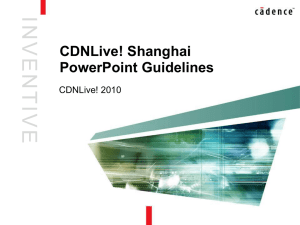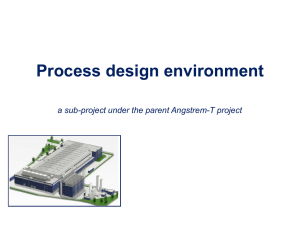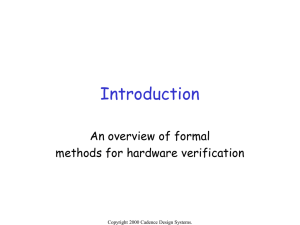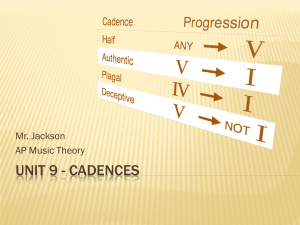CAV03 tutorial on SAT-based model checking
advertisement
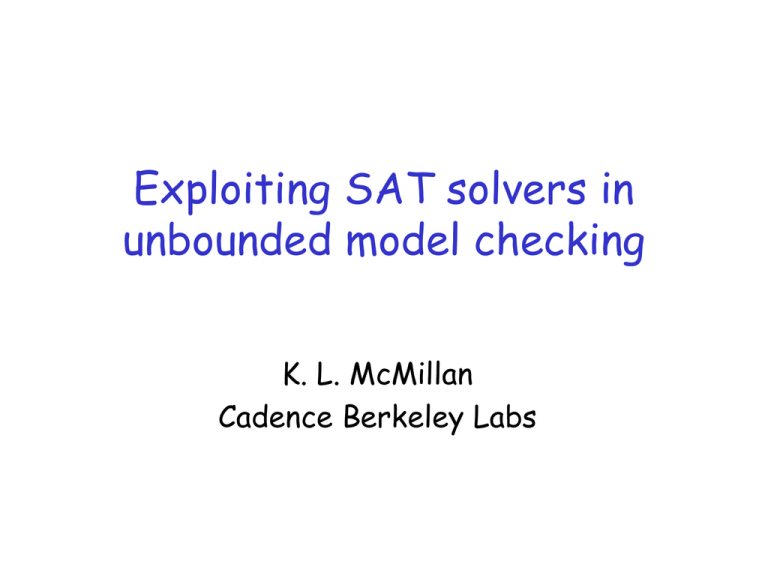
Exploiting SAT solvers in
unbounded model checking
K. L. McMillan
Cadence Berkeley Labs
DPLL-style SAT solvers
SATO,GRASP,CHAFF,BERKMIN
• Objective:
– Check satisfiability of a CNF formula
• literal: v or v
• clause: disjunction of literals
• CNF: conjunction of clauses
• Approach:
– Branch: make arbitrary decisions
– Propagate implication graph
– Use conflicts to guide inference steps
Copyright 2002 Cadence Design Systems.
The Implication Graph (BCP)
(a b) (b c d)
a
b
d
c
Decisions
Assignment: a b c d
Copyright 2002 Cadence Design Systems.
Resolution
a b c
a c d
b c d
When a conflict occurs, the implication graph is
used to guide the resolution of clauses, so that the
same conflict will not occur again.
Copyright 2002 Cadence Design Systems.
Conflict Clauses
(a b) (b c d) (b d)
resolve
a
c
(b c )
b
Conflict!
Conflict!
(a c)
d
resolve
Conflict!
Decisions
Assignment: a b c d
Copyright 2002 Cadence Design Systems.
Conflict Clauses (cont.)
• Conflict clauses:
–
–
–
–
Are generated by resolution
Are implied by existing clauses
Are in conflict in the current assignment
Are safely added to the clause set
Many heuristics are available for determining
when to terminate the resolution process.
Copyright 2002 Cadence Design Systems.
Basic SAT algorithm
A=
empty
clause?
y
UNSAT
n
Deduce conflict
clause and
backtrack
Branch:
add some literal
to A
y
conflict?
is A
total?
Copyright 2002 Cadence Design Systems.
y
SAT
Generating refutations
• Refutation = a proof of the null clause
– Record a DAG containing all resolution steps
performed during conflict clause generation.
– When null clause is generated, we can extract a
proof of the null clause as a resolution DAG.
Original clauses
Derived clauses
Null clause
Copyright 2002 Cadence Design Systems.
Circuit SAT
Can the circuit output be 1?
CNF(p)
(a g) (b g)
(a b g)
a
b
c
input
variables
g
p
output
variable
(g p) (c p)
(g c p)
p is satisfiable when the
formula CNF(p) p
is satisfiable
Copyright 2002 Cadence Design Systems.
Bounded Model Checking
BCCZ99
• Given
– A finite transition system M
– A property p
• Determine
– Does M allow a counterexample to p of k transitions
of fewer?
This problem can be translated to a SAT problem
Copyright 2002 Cadence Design Systems.
Models
Transition system described by a set of
constraints
g=ab
g
a
b
Model:
c' = p
p
C={
c
p=gc
}
g = a b,
p = g c,
c' = p
Each circuit element is a constraint
note: a = at and a' = at+1
Copyright 2002 Cadence Design Systems.
Properties
• We restrict our attention to safety
properties.
• Characterized by:
– Initial condition I
– Final condition F (representing "bad" states)
• A counterexample is a path from a state
satisfying I to state satisfying F, where every
transition satisfies C.
Copyright 2002 Cadence Design Systems.
Unfolding
• Unfold the model k times:
Uk = C0 C1 ... Ck-1
I0
a
b
g
p
c
a
b
g
p
c
...
a
b
g
p
c
• Use SAT solver to check satisfiability of
I0 Uk Fk
• A satisfying assignment is a counterexample
of k steps
Copyright 2002 Cadence Design Systems.
Fk
BMC applications
• Debugging:
– Can find counterexamples using a SAT solver
• Proving properties:
– Only possible if a bound on the length of the
shortest counterexample is known.
• I.e., we need a diameter bound. The diameter is the
maximum lenth of the shortest path between any two
states.
– Worst case is exponential. Obtaining better bounds
is sometimes possible, but generally intractable.
Copyright 2002 Cadence Design Systems.
Unbounded Model Checking
• We consider a variety of methods to explioit
SAT and BMC for unbounded model checking:
– K-step induction
– Abstraction
• Counterexample-based
• Non-counterexample-based
– Exact image computations
• SAT solver tests for fixed point
• SAT solver computes image
– Over-approximate image computations
Copyright 2002 Cadence Design Systems.
K-induction
• Induction:
P(s0)
"i: P(si) P(si+1)
"i: P(si)
• k-step induction:
P(s0..k-1)
"i: P(si..i+k-1) P(si+k)
"i: P(si)
Copyright 2002 Cadence Design Systems.
SSS2000
K-induction with a SAT solver
• Recall:
Uk = C0 C1 ... Ck-1
• Two formulas to check:
– Base case:
I0 Uk-1 P0...Pk-1
– Induction step:
Uk P0...Pk-1 Pk
• If both are valid, then P always holds.
• If not, increase k and try again.
Copyright 2002 Cadence Design Systems.
Simple path assumption
• Unfortunately, k-induction is not complete.
– Some properties not k-inductive for any k.
P
P
• Simple path restriction:
P
– There is a path to P iff there is a simple path to
P (path with no repeated states).
Copyright 2002 Cadence Design Systems.
Induction over simple paths
• Let simple(s0..k) be defined as:
"i,j in 0..k : (i j) si sj
• k-induction over simple paths:
P(s0..k-1)
"i: simple(s0..k) P(si..i+k-1) P(si+k)
"i: P(si)
Must hold for k large enough, since a simple path cannot be
unboundedly long. Length of longest simple path is called
recurrence diameter.
Copyright 2002 Cadence Design Systems.
...with a SAT solver
• For simple path restriction, let:
Sk = "t=0..k, t'=t+1..k: "v in V : vt = vt'
(where V is the set of state variables).
• Two formulas to check:
– Base case:
I0 Uk-1 P0...Pk-1
– Induction step:
Sk Uk P0...Pk-1 Pk
• If both are valid, then P always holds.
• If not, increase k and try again.
Copyright 2002 Cadence Design Systems.
Termination
• Termination condition:
k is the length of the longest simple path of the form
P* P
• This can be exponentially longer than the
diameter.
– example:
• loadable mod 2N counter where P is (count 2N-1)
• diameter = 1
• longest simple path = 2N
• Nice special cases:
– P is a tautology (k=0)
– P is inductive invariant (k=1)
Copyright 2002 Cadence Design Systems.
Localization abstraction
Kurshan
• Property: G (c X c)
free variable
a
b
g
Model:
C'= {
p
c
}
C'property, C C'
C property
Copyright 2002 Cadence Design Systems.
g = a b,
p = g c,
c' = p
Constraint granularity
Most authors use constraints at "latch" granularity...
a
b
Model:
g
p
c
C={
}
c' = (a b) c
...however, techniques we will consider can be applied at
both "gate" and "latch" granularity.
Copyright 2002 Cadence Design Systems.
Localization, cont
• C' may refer to fewer state variables than C
– reduction in the state explosion problem
• Key issue: how to choose constraints in C'
– counterexample-based
– proof-based
Copyright 2002 Cadence Design Systems.
Algorithm
Kurshan
Choose initial C'
SAT uses
Model check
abstraction C'
Cex
true, done
Can extend Cex
from C'to C?
no
yes, Cex
Add constraints
to C'
Copyright 2002 Cadence Design Systems.
Abstract counterexamples
• Assume simple safety property:
– initial condition I and final condition F
– w.l.o.g., assume I and F are atomic formulas
• to make this true, add constraints in C:
vI I
vF F
• Abstract variables V' = support(C',I,F)
• Abstract counterexample A' is a truth
assignment to:
{ vt | v in V', t in 0..k }
where k is the number of steps.
Copyright 2002 Cadence Design Systems.
Counterexample extension
CGJLV 2000
• Abstract counterexample A' satisfies:
I0 U'k Fk where U'k = C'0 C'1 ... C'k-1
• Find A consistent with A', satisfying:
I0 Uk Fk where Uk = C0 C1 ... Ck-1
• That is, A is any satisfying assignment to:
A' I0 Uk Fk
I.e., to extend an abstract counterexample, we just
apply it as a constraint in BMC. If unsat, abstract
counterexample is "false".
Copyright 2002 Cadence Design Systems.
Abstraction refinement
• Refinement = adding constraints to C' to
eliminate false counterexamples.
• Many heuristsics used for this.
– Too many to cover here.
– Recall that a SAT solver can produce a resolutionbased refutation in the UNSAT case....
Copyright 2002 Cadence Design Systems.
Proof-based refinement
• Recall, to extend abstract Cex A', we check:
A' I0 Uk Fk
• If UNSAT, we obtain refutation proof P
– proof that A' cannot be extended to concrete Cex
• Let E be set of constraints used in proof P:
E = { c C | some ci occurs in P }
• A' cannot be extended to a Cex for E
– P is the proof of this.
Thus, add E to C' and continue...
Copyright 2002 Cadence Design Systems.
In other words...
The refutation of the formula:
A' I0 Uk Fk
gives us a sufficient set of constraints to rule
out the abstract counterexample.
We continue ruling out counterexamples until either the
abstraction C' proves the property or we can extend an
abstract counterexample to a concrete one.
Copyright 2002 Cadence Design Systems.
CCKSVW approach (FMCAD02)
• Find the shortest prefix of Cex A' that
cannot be extended.
OK
s0
OK
s1
OK
s2
OK
...
si-1
NO!
si
• That is,
A' I0 Uk Fk
is feasible for all k < i, but not for k=i.
Copyright 2002 Cadence Design Systems.
CCKSVW approach cont.
•
•
Let P be a refutation of
A' I0 Ui Fi
Let E be set of constraints used in proof P
only on state si-1:
E = { c C | ci-2 occurs in P }
OK
s0
OK
s1
OK
s2
OK
...
add constraints used here
Copyright 2002 Cadence Design Systems.
si-1
NO!
si
Weakness of Cex-based approach
• Arbitrarily chosen abstract Cex may be
refutable for many reasons not related to
property.
– Thus, may add irrelevant constraints.
– To remedy, may try to characterize a set of Cex's
rather than just one (e.g., GKM-HFV,TACAS03).
Alternative: don't use counterexamples
Copyright 2002 Cadence Design Systems.
Proof-based abstraction
BMC
at depth k
MA,TACAS03
Cex?
done
Increase k
No Cex?
Use refutation to
choose abstraction
MC abstraction
False?
Copyright 2002 Cadence Design Systems.
True?
done
BMC phase
• Unfold the model k times:
U = C0 C1 ... Ck-1
• Use SAT solver to check satisfiability of
I0 U Fk
• If unsatisfiable:
• property has no Cex of length k
• produce a refutation proof P
Copyright 2002 Cadence Design Systems.
Abstraction phase
• Let C' be set of constraints used in proof P:
C' = { c C | some ci occurs in P }
• C' admits no counterexample of length k
– let U' = C'0 C'1 ... C'k-1
– P is a refutation of I0 U' Fk
• Model check property on C'
– property true for C' implies true for C
– else Cex of length k' > k (why?)
• restart for k = k'
Copyright 2002 Cadence Design Systems.
Algorithm
BMC
C at depth k
Cex?
done
let k = k'
No Cex?
Refutation P induces
abstraction C'
Model check C'
True?
Cex of depth k'?
Notice: MC counterexample is thrown away!
Copyright 2002 Cadence Design Systems.
done
Termination
• Depth k increases at each iteration
• Eventually k > d, diameter of C'
• If k > d, no counterexample is possible
In practice, termination uses occurs when k d/2
Usually, diameter C' << diameter of C
Copyright 2002 Cadence Design Systems.
Weakness of proof-based abs
• BMC must refute all counterexamples of
length k, while in Cex-based, BMC must refute
only one (partial) counterexample.
Copyright 2002 Cadence Design Systems.
PicoJavaII benchmarks
• Hardware Java virtual machine implementation
• Properties derived from verification of ICU
– handles cache, instruction prefetch and decode
• Original abstraction was manual
• Added neigboring IFU to make problem harder
properties
Mem,
Cache
ICU
IFU
Integer
unit
No properties can be verified by standard model checking!
Copyright 2002 Cadence Design Systems.
Abstraction results
400
350
354
345
State variables
305 306 306 305
312
307
292
300
289
285
250
212
200
151
150
126
104
100
97
73
52 54
50
51
0
solid = original, gray = manual, open = proof-based abstraction
Copyright 2002 Cadence Design Systems.
Inference
• SAT solver seems to be very effective at
narrowing down the proof to relevant facts.
In most cases, it did better than manual abstraction.
Copyright 2002 Cadence Design Systems.
Comparing CBA and PBA
• Apples-apples comparison
– same SAT solver
– same model checker
– only differences are:
• For CBA previous A' is kept as a constriaint for BMC, C' is
cumulative.
• For PBA previous A' and C' are thrown away each
iteration.
Note these are my implementations. This says nothing
about performance of specific tools!
Copyright 2002 Cadence Design Systems.
Run time comparison
Proof-based abstraction
1000
100
10
1
0.1
0.01
0.01
0.1
1
10
100
Counterexample-based abstraction
Copyright 2002 Cadence Design Systems.
1000
Abstraction comparison
Proof-based abstraction
60
50
40
30
20
10
0
0
10
20
30
40
50
Counterexample-based abstraction
Copyright 2002 Cadence Design Systems.
60
Possible explanation
• Internally, SAT solver is really doing CBA
a=0
b=1
c=0
d=1
decision stack
= abstract Cex A'
refutation of A'
decision heuristic
moves proof variables
up, into A'
Copyright 2002 Cadence Design Systems.
PBA run-time breakdown
100%
50%
0%
solid = BMC time, open = MC time
Copyright 2002 Cadence Design Systems.
CBA run-time breakdown
100%
50%
0%
solid = BMC time, open = MC time
Copyright 2002 Cadence Design Systems.
IBM GP benchmarks
1000
Baumgartner et al.
100
10
1
0.1
0.01
0.01
0.1
1
10
100
1000
Proof-based abstraction
Thanks to Jason Baumgartner
Copyright 2002 Cadence Design Systems.
Compare to K-induction on PicoJava
k-induction (FMCAD00) (s)
1000
100
10
1
0.1
0.01
0.01
0.1
1
10
100
Proof-based abstraction (s)
Copyright 2002 Cadence Design Systems.
1000
A (fuzzy) hypothesis
SAT-based BMC "succeeds" when number of
relevant variables is small, and fails otherwise.
"success" is BMC for k = diameter of relevant logic
• Parameterized models allowing no abstraction
Model
Max state vars
German protocol
42
"swap"
21
Copyright 2002 Cadence Design Systems.
Industrial benchmarks
700
Abstraction state variables
600
500
400
300
200
100
0
0
100
200
300
400
500
Original state variables
Copyright 2002 Cadence Design Systems.
600
700
Implications
• Most of the time if bounded model checking
succeeds, unbounded model checking also
succeeds using abstraction.
• No need to settle for time bounded result
• Bounded model checking may be applicable only
to localizable properties
Copyright 2002 Cadence Design Systems.
Image computation methods
• Symbolic model checking without BDD's
– Use SAT solver just for fixed-point detection
• Abdulla, Bjesse and Een 2000
• Williams, Biere, Clarke and Gupta 2000
– Adapt SAT solver to compute image directly
• McMillan, 2002
Copyright 2002 Cadence Design Systems.
Symbolic model checking
• Recall: Fixed point characterizaion of CTL:
EFp = m. Q p EX Q
• Reverse image:
EXp = $W. p < di / si >
state variable
input variables
transition function
Copyright 2002 Cadence Design Systems.
Syntactic expansion of
quantifiers
• By definition:
$w. p = p<0/w> p<1/w>
• Thus, we can compute reverse image by
syntactic expansion and simplification.
– note: expontential in number of inputs.
• Fixed-point series:
R0 = false
Ri+1 = p EX Ri
Terminates when Ri+1 Ri
(SAT problem)
Copyright 2002 Cadence Design Systems.
Limitations
• Syntactic quantifier elimination is exponential
– Method limited to circuits with very few inputs
– E.g., sequential arithmetic circuits
Copyright 2002 Cadence Design Systems.
Direct image computation
• Adapt SAT methods for image computation in
symbolic model checking
– Recall: this is essentially quantifier elimination
• Idea: reduce formula to CNF or DNF
– Make quantifier elimination easy
– Essentially, enumerate all satisfying assignments,
but in an efficient way (i.e., by covering them with
clauses or cubes).
Copyright 2002 Cadence Design Systems.
Circuit Validity
Can the circuit output be 0?
CNF(p)
(a g) (b g)
(a b g)
a
b
c
input
variables
VI
g
p
output
variable
(g p) (c p)
(g c p)
p is valid when the
formula CNF(p) p
is unsatisfiable
Copyright 2002 Cadence Design Systems.
CNF Characterization
Instead of checking validity of p, we now want
to derive a CNF formula over the input variables
VI that is logically equivalent to the circuit.
Idea: each time a satisfying assignment is
found, add a new “blocking clause” that rules
out this satisfying assignment.
The blocking clauses form our characterization
of p.
Copyright 2002 Cadence Design Systems.
Blocking clauses
• Blocking clauses must:
– be implied by p
– be in conflict in the current assignment
– involve only input variables (in VI)
Can we use conflict clauses as
blocking clauses?
Not quite...
Copyright 2002 Cadence Design Systems.
An example
g
a
b
Want to characterize p in CNF:
•Test satisfiability of CNF(p) p
p
c
Guess the assignment A = a
Implication graph:
a
b
g
p
c
Satisfying!
Problem:
We can’t infer anything
from p, because p is
already a root of the
graph.
Copyright 2002 Cadence Design Systems.
Alternate implication graph
g
a
b
p
c
Construct a new implication graph
rooted at the input variables.
Original
Alternate
a
b
a
g
b
c
c
p
g
p
Now we can always generate a conflict clause
from p using only input variables.
Copyright 2002 Cadence Design Systems.
Blocking clause example
g
a
b
p
c
p
Alternate graph
(g c p)
a
b
c
(g c)
g
(b g)
p
(b c)
We stop when the clause has only inputs
Copyright 2002 Cadence Design Systems.
CNF characterization algorithm
A =
empty
clause?
y
return
n
Deduce
Branch
y
conflict?
is A
total?
y
Copyright 2002 Cadence Design Systems.
Infer blocking
clause c’ from p.
Add c’ to f, .
Universal Quantifier Elimination
Given
• a circuit p, and
• a subset W of the input variables,
we want to compute a CNF formula equivalent to
"W.p
Idea: Eliminating in CNF formulas is trivial.
e.g.: "a. (a b) (a c d) = (b) (c d)
... just push " inside ...
Copyright 2002 Cadence Design Systems.
" - elimination algorithm
A =
empty
clause?
y
return
n
Deduce
Branch
y
conflict?
is A
total?
y
Copyright 2002 Cadence Design Systems.
Infer blocking
clause c’ from p.
Add "W.c’ to f, .
CTL Model Checking with SAT
AXp
p
AXp = "W. p < di / si >
state variable
input variables
transition function
Copyright 2002 Cadence Design Systems.
Recent related work
• Sheng, Hsiao (DATE 2003)
– Uses ATPG methods
• Chauhan, Clarke, Kroenig
– Computes forward rather than backward image
Copyright 2002 Cadence Design Systems.
Simplified PicoJavaII
benchmarks
• This method can't handle large numbers of
irrelevant variables directly.
– Like BDD method, it computes exact reachable
states.
– Comparable to BDD methods, not abstraction
methods.
• We compare the method to BDD's for a set of
benchmarks in which most of the irrelevant
logic is pruned out manually.
Copyright 2002 Cadence Design Systems.
Run time of SAT-based method (s)
Comparison with BDD’s
10 0 0 0
10 0 0
10 0
10
1
0 .1
0 .0 1
0 .0 1
0 .1
1
10
10 0
10 0 0
10 0 0 0
Run time of BDD-based method (s)
Note low variance in
times for BDD based
technique.
Note
low correlation
between the two methods.
Benchmarks may be
biased
in favor
of BDD’s.
SAT
based
method
may
are
better overall.
beBDD’s
a good
alternative
when BDD’s fail.
But note relative
immaturity of SAT
based method
Copyright 2002 Cadence Design Systems.
SAT-based image
• May provide a good alternative when BDD's
fail.
• Does not take advantage of SAT solver's
ability to filter out irrelevant facts, since
exact image is computed.
Copyright 2002 Cadence Design Systems.
Image over-approximation
• BMC and Craig interpolation allow us to
compute image over-approximatino relative to
property.
– Avoid computing exact image.
– Maintain SAT solver's advantage of filtering out
irrelevant facts.
Copyright 2002 Cadence Design Systems.
Interpolation
(Craig,57)
• If A B = false, there exists an interpolant
A' for (A,B) such that:
A A'
A' B = false
A' refers only to common variables of A,B
• Example:
– A = p q, B = q r,
A' = q
• New result
– given a resolution refutation of A B,
A' can be derived in linear time.
Copyright 2002 Cadence Design Systems.
(Pudlak,Krajicek,97)
Interpolation-based MC
• Interpolation gives us
– SAT-based algorithm for over-approximate image
computation, using interpolation
– SAT-only symbolic model checking
Copyright 2002 Cadence Design Systems.
Reachability
• Is there a path from I to F satisfying
transition constraint C?
• Reachability fixed point:
Ri+1
• Image operator:
R0 = I
= Ri Img(Ri,C)
R = Ri
Img(P,C) = lV'. $ V. (P C)
• F is reachable iff R F false
Copyright 2002 Cadence Design Systems.
Overapproximation
• An overapproximate image op. is Img' s.t.
for all P, Img(P,C) implies Img'(P,C)
• Overapprimate reachability:
R'i+1
R'0 = I
= R'i Img'(R'i,C)
R' = R'i
• Img' is adequate (w.r.t.) F, when
– if P cannot reach F, Img’(P,C) cannot reach F
• If Img' is adequate, then
– F is reachable iff R' F false
Copyright 2002 Cadence Design Systems.
Adequate image
Img(P,C)
P
F
Img’(P,C)
Reached from P
Can reach F
But how do you get an adequate Img'?
Copyright 2002 Cadence Design Systems.
k-adequate image operator
• Img' is k-adequate (w.r.t.) F, when
– if P cannot reach F,
Img’(P,C) cannot reach F within k steps
• Note, if k > diameter, then k-adequate is
equivalent to adequate.
Copyright 2002 Cadence Design Systems.
Interpolation-based image
• Idea -- use unfolding to enforce k-adequacy
A = P-1 C-1
B = C0 C1 ... Ck-1 Fk
A
P
B
C
C
C
C
C
C
C
F
t=k
t=0
Let Img'(P)0= A',
where A' is an interpolant for (A,B)...
Img' is k-adequate!
Copyright 2002 Cadence Design Systems.
Huh?
A
P
A'
C
C
B
C
C
C
C
C
F
t=k
t=0
• A A'
– Img(P,C) Img'(P,C)
• A' B = false
– Img'(P,C) cannot reach F in k steps
• Hence Img' is k-adequate overapprox.
But note, Img' is partial -- not defined if AB is sat.
Copyright 2002 Cadence Design Systems.
Intuition
A
P
A'
C
C
B
C
C
C
C
C
F
t=k
t=0
• A' tells is everything the SAT solver deduced
about the image of P in proving it can't reach
F in k steps.
• Hence, A' is in some sense an abstraction of
the image relative to the property.
Copyright 2002 Cadence Design Systems.
Reachability algorithm
let k = 0
repeat
if I can reach F within k steps, answer reachable
R=I
while Img'(R,C) F = false
R' = Img'(R,C) R
if R' = R answer unreachable
R = R'
end while
increase k
end repeat
Copyright 2002 Cadence Design Systems.
Termination
• Since k increases at every iteration,
eventually k > d, the diameter, in which case
Img' is adequate, and hence we terminate.
Notes:
– don't need to know when k > d in order to terminate
– often termination occurs with k << d
– depth bound for earlier method (Sheeran et al '00)
is "longest simple path", which can be exponentially
longer than diameter
Copyright 2002 Cadence Design Systems.
PicoJava II Benchmarks
Interpolation-based method (s)
1000
100
10
1
0.1
0.01
0.01
0.1
1
10
100
Proof-based abstraction (s)
Copyright 2002 Cadence Design Systems.
1000
vs. k-induction
k-induction (FMCAD00) (s)
1000
100
10
1
0.1
0.01
0.01
0.1
1
10
100
Interpolation-based (s)
Copyright 2002 Cadence Design Systems.
1000
IBM GP benchmarks
Interpolation-based method (s)
1000
100
10
1
0.1
0.01
0.01
0.1
1
10
100
Proof-based abstraction (s)
Copyright 2002 Cadence Design Systems.
1000
GP benchmarks - true properties
Interpolation-based method (s)
1000
100
10
1
0.1
0.01
0.01
0.1
1
10
100
Proof-based abstraction (s)
Copyright 2002 Cadence Design Systems.
1000
Interpolation-based MC
• Fully SAT-based.
• Inherits SAT solvers ability to concentrate on
facts relevant to a property.
• Like CBA, PBA, most effective when
– Very large set of facts is available
– Only a small subset are relevant to property
• For true properties, appears to converge for
smaller k values.
Copyright 2002 Cadence Design Systems.
Conclusion
• SAT solvers are very effective at ignoring
irrelevant facts
– Can think of decision heuristic as a form of CBA
• SAT solvers can produce refutations
• We can exploit in a number of ways:
– BMC
– Abstraction for UMC (either CBA or PBA)
– Abstract image computations using interpolation
This makes it possible to model check localizable
properties large systems.
Copyright 2002 Cadence Design Systems.
Conclusion cont.
• Approaches that compute exact images
sacrifice this quality of SAT solvers.
– still useful as alternative to BDD's
• For non-localizable properties, SAT-based
BMC and UMC do not perform well.
• The capacity of SAT-based UMC is
comparable to BMC.
– no need to settle for bounded results!
Copyright 2002 Cadence Design Systems.
